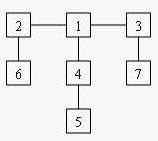poj1655 Balancing Act (dp? dfs?)
阿新 • • 發佈:2017-08-03
lan from bsp 樹的重心 case test case amp mit esp
For example, consider the tree:

Deleting node 4 yields two trees whose member nodes are {5} and {1,2,3,6,7}. The larger of these two trees has five nodes, thus the balance of node 4 is five. Deleting node 1 yields a forest of three trees of equal size: {2,6}, {3,7}, and {4,5}. Each of these trees has two nodes, so the balance of node 1 is two.
For each input tree, calculate the node that has the minimum balance. If multiple nodes have equal balance, output the one with the lowest number.
Balancing Act
| Time Limit: 1000MS | Memory Limit: 65536K | |
| Total Submissions: 14247 | Accepted: 6026 |
Description
Consider a tree T with N (1 <= N <= 20,000) nodes numbered 1...N. Deleting any node from the tree yields a forest: a collection of one or more trees. Define the balance of a node to be the size of the largest tree in the forest T created by deleting that node from T.For example, consider the tree:

Deleting node 4 yields two trees whose member nodes are {5} and {1,2,3,6,7}. The larger of these two trees has five nodes, thus the balance of node 4 is five. Deleting node 1 yields a forest of three trees of equal size: {2,6}, {3,7}, and {4,5}. Each of these trees has two nodes, so the balance of node 1 is two.
For each input tree, calculate the node that has the minimum balance. If multiple nodes have equal balance, output the one with the lowest number.
Input
Output
Sample Input
1 7 2 6 1 2 1 4 4 5 3 7 3 1
Sample Output
1 2
題意:
找樹的重心,即:
定義1:找到一個點,其所有的子樹中最大的子樹節點數最少,那麽這個點就是這棵樹的重心。
定義2:以這個點為根,那麽所有的子樹(不算整個樹自身)的大小都不超過整個樹大小的一半。
性質1:樹中所有點到某個點的距離和中,到重心的距離和是最小的;如果有兩個重心,那麽他們的距離和一樣。
性質2:把兩個樹通過一條邊相連得到一個新的樹,那麽新的樹的重心在連接原來兩個樹的重心的路徑上。
性質3:把一個樹添加或刪除一個葉子,那麽它的重心最多只移動一條邊的距離。
思路:
選取任意節點為根節點,dfs求當前節點所代表的子樹的節點總數(包含自己記為sum)和該節點的所有子樹中節點數最大值(記為ave)。則依據題意,刪除當前節點後的平衡值為
max(n-sum,ave);找到最小值輸出。
看到別人說是dp,可能我不會dp。
代碼:
#include<iostream> #include<cstdio> #include<vector> using namespace std; const int maxn = 2e4+4, INF = 0x3f3f3f3f; vector<int> grap[maxn]; int vis[maxn], sum[maxn], ave[maxn]; int t, n; int dfs(int x) { int res=1; for(int i=0; i<grap[x].size(); ++i) { int xx=grap[x][i]; if(vis[xx]) continue; vis[xx]=1; int kk=dfs(xx); ave[x]=max(ave[x], kk); res+=kk; vis[xx]=0; } sum[x]=res; ave[x]=max(ave[x], n-sum[x]); return res; } int main() { ios::sync_with_stdio(false); cin.tie(0); cout.tie(0); cin>>t; while(t--) { cin>>n; for(int i=1; i<=n; ++i) { grap[i].clear(); vis[i]=0; sum[i]=0; ave[i]=0; } for(int i=2; i<=n; ++i) { int u, v; cin>>u>>v; grap[u].push_back(v); grap[v].push_back(u); } vis[1]=1; dfs(1); int ans=INF, v=0; for(int i=1; i<=n; ++i) if(ans>ave[i]) ans=ave[i], v=i; cout<<v<<" "<<ans<<endl; } return 0; }
poj1655 Balancing Act (dp? dfs?)
